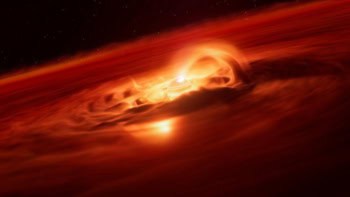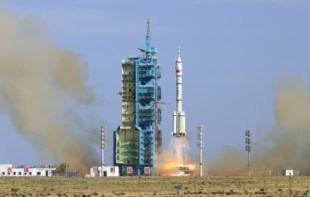
Astronomers in Canada and Germany have made the first direct measurement of the atmospheric spectrum of a planet outside our solar system. Using the European Southern Observatory (ESO) Very Large Telescope (VLT) in Chile the researchers studied the chemical composition of the planet’s atmosphere in isolation from the spectrum of its parent star. They say that this represents an important step forward in the search for life elsewhere in the universe.
Astronomers made the first discovery of a planet orbiting another star in 1992 and they have gone on to discover more than 400 extra-solar planets or exoplanets. A key aim of this research is to study the chemical composition of exoplanetary atmospheres because this provides information about a planet’s formation and evolution and it might also reveal the signatures of life. Extracting such spectroscopic data is extremely tricky, however, because the light emitted by an exoplanet is dwarfed by that of its host star.
Astronomers have previously made such measurements by using space telescopes to study an “exoplanetary eclipse”, when an exoplanet disappears behind its star. This allows the spectra of the planets to be extracted by comparing the starlight before and after the eclipse. This technique has revealed the existence of a number of atmospheric chemicals, such as water vapour and methane, but unfortunately it can only be used on those few exoplanets that happen to have just the right orbital inclination relative to the Earth’s line of sight.
Five-hour exposure
Now, Markus Janson of the University of Toronto and colleagues are the first to obtain an exoplanet spectrum directly, in other words studying the light that it gives off rather than monitoring changes in the spectrum of its host star. This requires imaging in the infrared, since a still-hot planet will radiate principally at these wavelengths, and to do this the researchers used the NACO infrared instrument mounted on the VLT. This involved more than five hours of exposure time and the use of a highly advanced adaptive optics system, which counteracts the effects of atmospheric turbulence by using actuators to make continuous tiny changes to the shape of the telescope’s mirror in response to distortions in the light from a reference star.
The exoplanet in question is called HR 8799c. It is the second of three planets known to orbit the star HR 8799, which is 130 light-years from Earth and has 1.5 times the mass of the Sun. Like its companions, HR 8799c is a giant gaseous planet, and is some 10 times more massive than Jupiter, has an orbital radius of 38 times the Sun–Earth distance and a temperature of about 1100 K.
As Janson explains, the chemical signature of HR 8799c is not that predicted by theory. “The current spectrum tells us that there is less methane than expected in the upper atmosphere, implying that the carbon is mostly locked up in carbon monoxide instead. This means that the planet may be enriched in heavy elements compared to its parent star, which would imply that the planet formed like the planets in our own solar system.”
Spying on the neighbours
The researchers’ next step is to measure the spectra of the two neighbouring planets to see whether these surprising features are common to all three or are particular to HR 8799c. There are then a handful of other exoplanets that could be studied in this way using NACO, while the SPHERE instrument, to be installed on the VLT in 2011, and the proposed 42 m European Extremely Large Telescope will expand this capability still further.
Carl Grillmair of the California Institute of Technology, who has obtained exoplanet spectra using the eclipse technique, believes that this latest work is “an important and logical next step for getting spectra of exoplanets”, adding that he is “extremely impressed” with the quality of the spectrum obtained by Janson’s group. But he points out that such ground-based observations only work well for very large, hot planets. “They most certainly won’t work for cooler, more Earth-like, and possibly life-bearing planets,” he says. “That will continue to remain the province of dedicated space-borne instrumentation”.
The work is described in a paper submitted to Astrophysical Journal Letters and a Preprint is available from the ESO.



